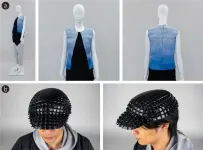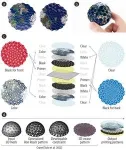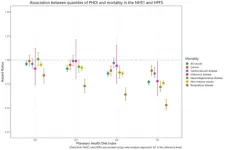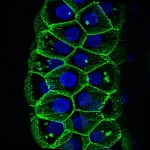(Press-News.org)
3D printing of complex objects typically takes a long time due to the printing process necessarily laying down a large number of 2D layers to build up the object. The process usually wastes a lot of material required to support the unfinished object. Some novel ways to make flat materials self-fold into 3D shapes exist, but have shortcomings. For the first time, researchers combined 2D printing, origami, and chemistry to create a method of rapid 3D object fabrication without creating any waste material. These shapes self-fold in seconds.
For some time, 3D printing has been used to prototype products and is now seeing more use in the fabrication of commercial items, including even parts for jet engines. But every method of 3D fabrication comes with limitations, such as the long time taken to complete prints or the wastage of vestigial materials in printing. 4D printing is a concept that aims to mitigate these issues using a minimal amount of materials, selected for having certain special properties, allowing them to self-fold into complex 3D shapes under the right conditions. It’s called 4D printing, as the process of self-folding necessarily makes use of time, which is often said to be the 4th dimension. Ironically, a new method of rapid 4D printing begins in the 2D realm.
“My team and I discovered how to use accessible tools and materials to create self-folding 4D objects,” said Project Assistant Professor Koya Narumi from the Department of Electrical Engineering and Information Systems at the University of Tokyo. “Essentially, we’re creating flat sheets with origami patterns on them, and these patterns can be complex, taking even a skilled origami artist hours to form. But thanks to our special process, you can pour hot water over these flat sheets and watch as they spring into complex 3D shapes in a matter of seconds.”
The technique utilizes a special kind of inkjet printer made for printing with UV-reactive materials — although the machine itself can cost tens of thousands of dollars, they are often found within maker communities and shared workshops. This printer prints a 2D origami design onto both sides of a plastic sheet that shrinks with heat. The ink it uses doesn’t shrink and can stay flexible when dry. As the base sheet shrinks when heated and the ink resists the shrinking, by leaving gaps between sections of ink on one side or the other, the designer can control which way a certain section of the sheet folds. Hot water is used to apply heat across the flat sheet so that it spontaneously folds into an intricate origami construction.
“Our biggest challenge was refining the options for hardware and materials, which took over a year to narrow it down to the final choices,” said Narumi. “But all the trial and error was worth it; compared to previous research around this same basic idea, we’ve improved the output resolution by 1,200 times, meaning the designs we can create are not just novelties, but can be used for real applications. In the future, we may explore functional materials, such as conductive or magnetic inks, that could allow for machines and other functional devices.”
Narumi and team hope this innovation can find use in various fields such as fashion, where material wastage is often high, especially in areas where bespoke designs are sought after. But given the pre-folded shapes are entirely flat, there’s also scope for this to be useful in any situation where there are tight logistical or storage concerns. Printed designs could even be posted, and the recipient could then heat them to turn them into the thing they ordered. And there could even be a use in the area of disaster recovery, where certain items, possibly including medical items, are needed but are often difficult to transport, and it becomes a lot easier when the items required are essentially flat.
###
Journal article: Koya Narumi*, Kazuki Koyama*, Kai Suto, Yuta Noma, Hiroki Sato, Tomohiro Tachi, Masaaki Sugimoto, Takeo Igarashi, and Yoshihiro Kawahara. (* joint first authors). Inkjet 4D Print: Self-folding Tessellated Origami Objects by Inkjet UV Printing. ACM Transactions on Graphics. https://doi.org/10.1145/3592409
Funding:
This research was partially supported by JST ACT-I, Grant Number JPMJPR18UN; Value Exchange Engineering, a joint research project between Mercari, Inc and RIISE; and JST AdCORP, Grant Number JPMJKB2302.
Useful links:
Department of Electrical Engineering and Information Systems
https://www.eeis.t.u-tokyo.ac.jp/en/
Koya Narumi
https://narumi.me/
Research contact:
Project Assistant Professor Koya Narumi
Graduate School of Engineering, The University of Tokyo,
7-3-1 Hongo, Bunkyo-ku, Tokyo, 113-0033, Japan
narumi@akg.t.u-tokyo.ac.jp
Press contact:
Mr. Rohan Mehra
Public Relations Group, The University of Tokyo,
7-3-1 Hongo, Bunkyo-ku, Tokyo, 113-8656, Japan
press-releases.adm@gs.mail.u-tokyo.ac.jp
About The University of Tokyo
The University of Tokyo is Japan's leading university and one of the world's top research universities. The vast research output of some 6,000 researchers is published in the world's top journals across the arts and sciences. Our vibrant student body of around 15,000 undergraduate and 15,000 graduate students includes over 4,000 international students. Find out more at www.u-tokyo.ac.jp/en/ or follow us on Twitter at @UTokyo_News_en.
END
A diet originally designed to help ward off cognitive decline in adults might also help improve attention in pre-adolescents, according to a new study. The findings could help inform future dietary interventions aimed at improving cognition in children.
The new study examined two diets: the Healthy Eating Index – 2015 (HEI-2015), which is based on the Dietary Guidelines for Americans, and the Mediterranean-DASH Intervention for Neurodegenerative Delay (MIND) diet, which combines the Mediterranean diet with the heart-healthy Dietary Approaches to Stop Hypertension ...
Eating more planet-friendly foods could help you live a longer, healthier life, according to new research. Researchers found that people who followed a more environmentally sustainable diet were 25% less likely to die during a follow-up period of over 30 years compared to those with a less sustainable diet.
The study builds upon prior research that identified foods that are a win-win for both health and the environment—such as whole grains, fruit, non-starchy vegetables, nuts, and unsaturated oils—as well as foods that could be harmful to the environment and human health, like eggs ...
A study of over 10,000 children in rural Pennsylvania revealed that a large proportion of children were fed foods that are high in sugar and salt in their first years of life.
Over half (53%) of the children in the study received high-sodium meats such as hot dogs, 37% received salty snacks such as potato chips, and one-third (34%) received cakes, cookies, or pudding before age 2. In addition, over one-quarter (27%) of babies received juice before their first birthday.
“Given ...
Systematic review of 8 studies in more than 7,700 serodiscordant couples in 25 countries finds people living with HIV with viral loads less than 1,000 copies/mL have almost zero risk of transmitting the virus to their sexual partners. Previous studies have not been able to confirm a lack of transmission risk above 200 copies/mL.
Systematic review also consolidates and reinforces previous studies that have found there is zero risk of transmitting the virus to sexual partners when people living with HIV have an undetectable viral load.
Of the more than 320 documented sexual HIV transmissions ...
In one of the first large-scale studies of genes related to diet, researchers have uncovered almost 500 genes that appear to directly influence the foods we eat. The findings represent an important step toward using a person’s genetics to develop precision nutrition strategies that help improve health or prevent disease.
“Some genes we identified are related to sensory pathways — including those for taste, smell, and texture — and may also increase the reward response in the brain,” said research team leader Joanne Cole, PhD, assistant professor in the Department ...
There is growing evidence that consuming prebiotics — certain types of fiber often found in plants that stimulate beneficial bacteria in your gut — can help to maintain a healthy gut microbiome. In a new study, scientists estimated the prebiotic content of thousands of food types by using preexisting literature to find out which foods offer the highest prebiotic content.
According to the study, foods that pack the greatest prebiotic punch are dandelion greens, Jerusalem artichokes, garlic, leeks, and onions. In addition to supporting gut microbes, prebiotic rich ...
A University of Texas at Arlington engineering researcher is working on defenses that could thwart cyberattacks against networks of self-driving cars and unmanned aerial vehicles.
Animesh Chakravarthy, associate professor in the Department of Mechanical and Aerospace Engineering (MAE), is the principal investigator on an approximately $800,000 U.S. Department of Defense grant titled “Resilient Multi-Vehicle Networks.” MAE Professor Kamesh Subbarao, and Bill Beksi, assistant professor ...
Using electrochemistry to separate different particles within a solution (also known as electrochemical separation) is an energy-efficient strategy for environmental and water remediation: the process of purifying contaminated water. But while electrochemistry uses less energy than other, similar methods, the electric energy is largely derived from nonrenewable sources like fossil fuels.
Chemists at the University of Illinois Urbana-Champaign have demonstrated that water remediation can be powered in part — and ...
Millions of deaths and ongoing illnesses caused by the COVID-19 pandemic have prompted scientists to seek new ways of understanding how viruses so skillfully enter and reprogram human cells. Urgent innovations leading to the development of new therapies are needed since virologists predict that future deadly viruses and pandemics may again emerge from the coronavirus family.
One approach to developing new treatments for such coronaviruses, including the SARS-CoV-2 virus that causes COVID-19, is to block the mechanisms by which the virus reprograms our cells and forces them to produce more viral particles. But studies have identified nearly 1,000 human proteins ...
The worms that cause schistosomiasis (Schistosoma mansoni) are unusual in several ways, especially the fact that male and female adults must stay paired together throughout their lives for reproduction to be successful. Females may produce as many as 3,000 eggs per day. Approximately half reach the host’s gut or bladder. The rest are swept away via the blood to the liver and spleen, where they cause severe inflammation and liver cirrhosis, the main cause of mortality.
Researchers at Butantan Institute ...







